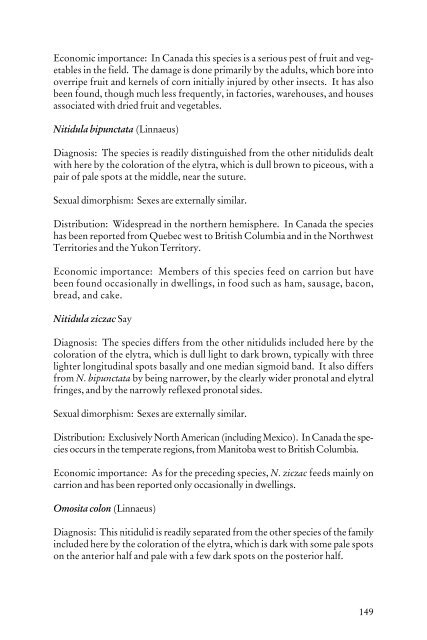Beetles Identification Guide
Beetles Identification Guide
Beetles Identification Guide
Create successful ePaper yourself
Turn your PDF publications into a flip-book with our unique Google optimized e-Paper software.
Economic importance: In Canada this species is a serious pest of fruit and vegetables<br />
in the field. The damage is done primarily by the adults, which bore into<br />
overripe fruit and kernels of corn initially injured by other insects. It has also<br />
been found, though much less frequently, in factories, warehouses, and houses<br />
associated with dried fruit and vegetables.<br />
Nitidula bipunctata (Linnaeus)<br />
Diagnosis: The species is readily distinguished from the other nitidulids dealt<br />
with here by the coloration of the elytra, which is dull brown to piceous, with a<br />
pair of pale spots at the middle, near the suture.<br />
Sexual dimorphism: Sexes are externally similar.<br />
Distribution: Widespread in the northern hemisphere. In Canada the species<br />
has been reported from Quebec west to British Columbia and in the Northwest<br />
Territories and the Yukon Territory.<br />
Economic importance: Members of this species feed on carrion but have<br />
been found occasionally in dwellings, in food such as ham, sausage, bacon,<br />
bread, and cake.<br />
Nitidula ziczac Say<br />
Diagnosis: The species differs from the other nitidulids included here by the<br />
coloration of the elytra, which is dull light to dark brown, typically with three<br />
lighter longitudinal spots basally and one median sigmoid band. It also differs<br />
from N. bipunctata by being narrower, by the clearly wider pronotal and elytral<br />
fringes, and by the narrowly reflexed pronotal sides.<br />
Sexual dimorphism: Sexes are externally similar.<br />
Distribution: Exclusively North American (including Mexico). In Canada the species<br />
occurs in the temperate regions, from Manitoba west to British Columbia.<br />
Economic importance: As for the preceding species, N. ziczac feeds mainly on<br />
carrion and has been reported only occasionally in dwellings.<br />
Omosita colon (Linnaeus)<br />
Diagnosis: This nitidulid is readily separated from the other species of the family<br />
included here by the coloration of the elytra, which is dark with some pale spots<br />
on the anterior half and pale with a few dark spots on the posterior half.<br />
149
















